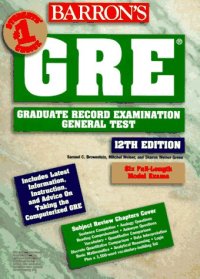
Ebook: Barron's GRE: Graduate Record Examination General Test
- Year: 1997
- Publisher: Barron's Educational Series Inc.
- Edition: 12th
- Language: English
- pdf
I have in my procession about 4 different GRE books that is current. The Barron one is the worst of them all. I choose here focus my critique on its quantitative part because I am doing well in this part, not thanks to Barron. Of utmost importance, there are some statement in their statements in mathematics, which is unforgivable.
Pros (general):
1. Contain the most mock test that has explanations to the correct choices
2. Has ONE math trick that no other books have--though it turns out less useful than I thought...
Cons (quantitative):
1. It's hard to read: sentences and vocabulary inconsistent with what is used in the GRE itself. It could just be me, since I was educated under the British educational system rather than the USA's, thus unfamiliar with the terminology commonly understood.
2. The quantitative questions are often vaguely stated, for example:
"In 1975 what percent of female college students were at least 25 years old" [ref: pg 328 under the "Data Interpretation Questions"]. This could be interpreted to mean (A) amongst the females, how many % are 25+? or; (B) amongst ALL students, how many are 25+ females? Barron was in fact asking for the former.
Many of their questions are like that. Be aware. ETS would NEVER do something like this, think now many hours of complaints would they have to deal with! No other books have this problem.
3. The mock quantitative tests' questions are too much harder than the ETS questions, thus rendering them useless as practise.
I understand the principle of training on harder questions than one would encounter just to be over-trained. However, Barron's questions so far exceeds the need of the GRE--unfortunately this is mainly due to its ambiguous language--as to make it irrelevant to the GRE.
4. Examples of false information
Page 335:
"Every integer has a finite set of factors (or divisors) and a infinite set of multiples."
EXCEPT FOR ZERO: 0 has an infinite number of factors, since anything multiply by 0 = 0, so EVERY number is a factor of 0.
Pros (general):
1. Contain the most mock test that has explanations to the correct choices
2. Has ONE math trick that no other books have--though it turns out less useful than I thought...
Cons (quantitative):
1. It's hard to read: sentences and vocabulary inconsistent with what is used in the GRE itself. It could just be me, since I was educated under the British educational system rather than the USA's, thus unfamiliar with the terminology commonly understood.
2. The quantitative questions are often vaguely stated, for example:
"In 1975 what percent of female college students were at least 25 years old" [ref: pg 328 under the "Data Interpretation Questions"]. This could be interpreted to mean (A) amongst the females, how many % are 25+? or; (B) amongst ALL students, how many are 25+ females? Barron was in fact asking for the former.
Many of their questions are like that. Be aware. ETS would NEVER do something like this, think now many hours of complaints would they have to deal with! No other books have this problem.
3. The mock quantitative tests' questions are too much harder than the ETS questions, thus rendering them useless as practise.
I understand the principle of training on harder questions than one would encounter just to be over-trained. However, Barron's questions so far exceeds the need of the GRE--unfortunately this is mainly due to its ambiguous language--as to make it irrelevant to the GRE.
4. Examples of false information
Page 335:
"Every integer has a finite set of factors (or divisors) and a infinite set of multiples."
EXCEPT FOR ZERO: 0 has an infinite number of factors, since anything multiply by 0 = 0, so EVERY number is a factor of 0.
Download the book Barron's GRE: Graduate Record Examination General Test for free or read online
Continue reading on any device:

Last viewed books
Related books
{related-news}
Comments (0)